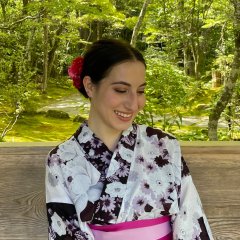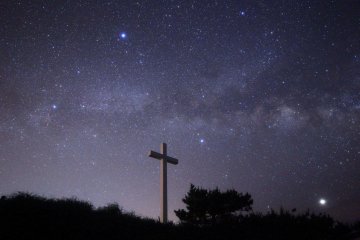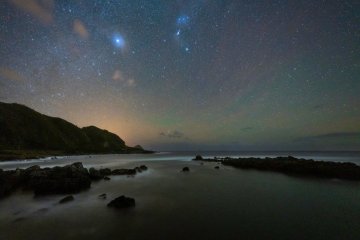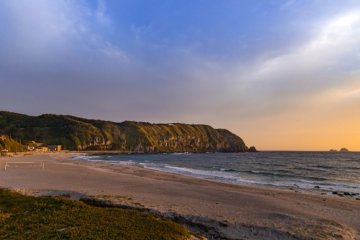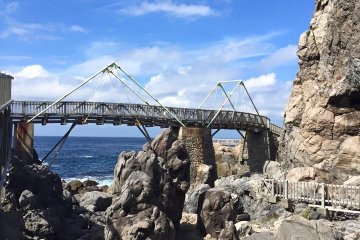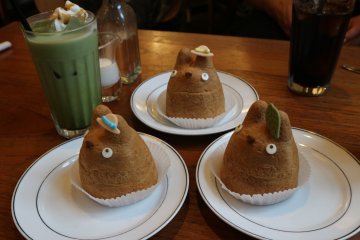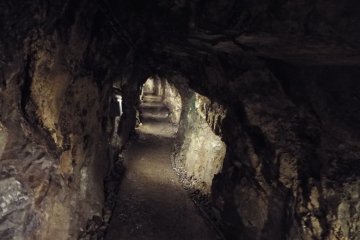Set out on an exotic journey in Tokyo.
Although Tokyo is renowned for its expansive cityscape, the prefecture is more than just an urban jungle and encompasses a collection of islands that extend south into the Pacific Ocean. One such island is Miyakejima.

Miyakejima is located approximately 180 kilometers south of mainland Tokyo and is a part of the Izu Islands. With Mt. Oyama—an active volcano—at its center, the island is best known for its blackened volcanic landscapes, ocean vistas, and lush greenery. Here, you can enjoy outdoor activities that bring you closer to both the land and sea.
I spent two days on Miyakejima and was fortunate enough to meet a number of friendly locals. Read on to learn more about this special island through my personal experiences and the voices of passionate residents.
Ocean: Sea life and coastal lookouts
Snorkeling

Given its clear water and flourishing sealife, it is no surprise that Miyakejima is an excellent place for snorkeling. In these crystal waters you can encounter over 600 sea creature species and more than 90 species of coral. Since snorkeling requires minimal equipment, both beginners and advanced divers can confidently enjoy it!
For my snorkeling adventure, I started where land meets sea on one of Miyakejima’s beaches. After securing my snorkeling goggles, I slowly entered the ocean. Cradled by the buoyancy of my life jacket, I encountered a variety of charming fish, as well as intermingling species of coral on the forest floor. Filtered sunbeams added an ethereal touch to my excursion, and I was fully immersed—both literally and figuratively—in the often unseen realm.
Megane-iwa Rock

Situated just off Miyakejima’s western coast, Megane-iwa Rock is a unique rock formation crafted by lava flow and years of erosion. The geological landmark earned the name Megane-iwa Rock, which translates to “spectacles stone” in English, since it had a double archway that resembled a pair of spectacles. Unfortunately, in 1959, a typhoon caused one of the arches to collapse, leaving only one in its wake.
Even so, the vibrant ocean juxtaposed against the rugged archway, coupled with the sea breeze and ever-present sound of the tide, makes for a viewing experience that a photo can never capture.
- Address: Miyake, Miyake Island, Tokyo 100-1212
- Google map: Megane-iwa Rock
- Website: https://www.miyakejima.gr.jp/see/glassesrock/
Mt. Nippana Shinzan

Formed by lava from Mt. Oyama’s 1983 eruption, which occurred on the mountain’s mid-slope, Mt. Nippana Shinzan is a volcanic cliff characterized by its beautiful red and black striations. The coastal area leading up to the cliff is marred by volcanic rock and largely devoid of plant life, making the hues of the ocean, sky, red rock, and greenery even more vivid. From the volcanic field, I was also treated to unobstructed views of the horizon and Miyakejima’s neighboring island Mikurashima. I was completely enamored by the exotic display of nature.
- Address: Miyake, Miyake Island, Tokyo 100-1212
- Google map: Mt. Nippana Shinzan
- Website: https://www.miyakejima.gr.jp/see/nippana/
Shichito Observatory

Situated closer to Miyakejima’s center and formed during the 1983 eruption, the Shichito Observatory is a place where you can view seven islands. From the right side, you can see Izu-Oshima, Toshima, Niijima, Shikinejima, and Kozushima, and from the left, you can see Mikurashima and Hachijojima. Hachijojima and its neighboring island Hachijo-kojima are only visible a few times a year. So, I was incredibly excited when both made an appearance during my trip!
- Address: Miyake, Miyake Island, Tokyo 100-1212
- Google map: Shichito Observatory
- Website: https://www.miyakejima.gr.jp/see/shichitoutenboudai/
Miyakejima’s “Geo Spots”

Miyakejima is dotted with numerous eruption sites called “Geo spots” where you can explore stunning volcanic landscapes. For example, from Mt. Sanshichiyama—the site of the 1962 eruption—you can see Mt. Hyotan—the site of the 1940 eruption. There are maps at each “Geo Spot” in English and Japanese that provide further information about the area. As with most of the island, the views from these “Geo Spots” are extraordinary.
At Mt. Hyotan, I trekked up the mountain’s side and then strolled along the crater’s perimeter. From this elevated spot, I was granted breathtaking panoramas of Miyakejima’s black and verdant landscape, as well as the shimmering sea. Looking down into the crater itself, I observed a variety of plant life emerging from the black-red soil.
- Address: Miyake, Miyake Island, Tokyo 100-1212
- Google map (Mt. Sanshichiyama): Mt. Sanshichiyama Lookout
- Website: https://www.miyakejima.gr.jp/see/sanshichiyamatenboudai/
- Google map (Mt. Hyotan): Mt. Hyotan
- Website: https://www.miyakejima.gr.jp/see/hyoutanyama/
Izu-misaki Lighthouse at sunset

Built in 1909 on Miyakejima’s northwestern coast, Izu-misaki Lighthouse has become a popular sunset spot. I arrived at the lighthouse about 30 minutes prior to sunset, and a small number of people had already started to gather. The comforting melody of water against the shore and the occasional bird chirp, instantly lulled me into utter contentment.
As the sun began its descent, a sparkling path of yellow appeared on the tide. From the horizon, the sky took on a spellbinding gradient of soft yellow to orangish-pink to a gradually deepening blue. Thanks to the exceptionally clear weather, I could also see the darkened silhouettes of nearby islands Kozushima, Shikinejima, Niijima, and Toshima. Once the sun finally fell below the horizon, spectacular sunbeams and shadows stretched across the sky. The entire viewing experience was nothing short of magical.
- Address: Miyake, Miyake Island, Tokyo 100-1212
- Google map: Izu Cape Lighthouse
- Website: https://www.miyakejima.gr.jp/see/izumisaki/
Land: Landscapes and animal life
Cycling

Miyakejima’s coastal roads and largely unobstructed scenery make it an ideal place for some scenic biking! The Miyakejima Tourist Association offers e-bike rentals and has English documentation available for tourists. After picking up my bike, I followed a road northward to the aforementioned Megane-iwa Rock.
With the bike’s electric support, I was able to climb hills and glide along the road with ease. As I pedaled, the wind against my face grew stronger, providing a reprieve from summer’s heat and unleashing my inner adventurer. I openly grinned as I admired the ocean to my left and lush mountains to my right. The experience was simultaneously freeing and awe-inspiring. Since Miyakejima is relatively small, I was able to visit numerous sights with ease.
- Address: 672-3 Ako, Miyake, Miyake Island, Tokyo 100-1212
- Google map: Miyakejima Tourist Association
- Business hours: 8:30am–5pm
- Closed: None
- Website: https://www.miyakejima.gr.jp/play/bicyclerental/
Ako Lava Trail

Mt. Oyama’s mid-slope erupted on October 3, 1983 and sent out lava flow in three different directions. The largest lava flow moved west to the Ako area, where approximately 1,300 people lived. This area was famous for its hot springs, with each household having its own hot spring bath. The lava buried more than 340 houses across a nearly 19-hectare area and in some places, reached a height of 10 meters. Fortunately, given the island’s disaster preparedness and training, everyone was able to escape safely. Today, this hardened lava field is open to visitors and has a wooden walkway that weaves through the black landscape.
As I traversed the forever changed land, it was hard to comprehend that hundreds of homes were buried beneath the barren field. The ruins of Ako Junior High School and Ako Elementary School best convey the true devastation of the eruption. Only the skeleton of the elementary school’s gymnasium remains, a combination of concrete walls and twisted metal beams. The lava flow reached the elementary school’s second floor, leaving the third floor untouched. Now the empty floor feels like an abandoned time capsule of the past.
Despite the destruction, the area is visually stunning and serves as a symbol of Miyakejima’s regenerative and resilient spirit. Similar to how plant life has begun to sprout through the hardened lava, islanders continue to rise above their hardships.
- Address: 224 Ako, Miyake, Miyake Island, Tokyo 100-1212
- Google map: 火山体験遊歩道
- Website: https://www.miyakejima.gr.jp/see/kazantaikenyuhodou/
Birdwatching at Akakokko Station and Tairo Pond
Despite its small size, Miyakejima is home to a number of bird species endemic to Japan and thus, is designated as an IBA (Important Bird Area) by the Wild Bird Society of Japan. The best place to learn about the island’s natural environment is Akakokko Station, named after the island’s representative bird Akakokko, or Izu Thrush in English. Akakokko Station is both a nature center and bird sanctuary where you can read about Miyakejima’s birds, sea life, and volcanic activity. The center has Japanese and English descriptions.
During my visit, I sat down with Mr. Naito, a ranger of the Wild Bird Society of Japan, to gain more insight into the island’s environment.

Mr. Naito has been a ranger for about 15 years and is originally from Chiba Prefecture. His love for wildlife inspired him to become a ranger. During our conversation, Mr. Naito stressed the importance of nature and wildlife preservation. All species, even ones that are not internationally known, play a crucial role in the environment. For instance, the Izu Thrush only lives and breeds in Japan. Mr. Naito wants to share these lesser known species with visitors.

When I pivoted the conversation to the topic of birdwatching, Mr. Naito’s eyes lit up. For birdwatching spots, Mr. Naito recommends Tairo Pond and Izu-misaki. Tairo Pond is especially active during spring and is home to numerous birds you cannot see in other parts of Japan, such as the Izu Thrush and Ijima's Leaf Warbler, which has a pleasant chirp. At Izu-misaki, the coastal area near the aforementioned lighthouse, you can witness migrating birds, as well as Styan's Grasshopper Warbler.


Mr. Naito’s personal favorite is Satado Cape on the eastern side of Miyakejima. This area is home to the Pacific Swift, which are fast-flying birds that people can observe up close. Mr. Naito finds it exciting to listen to the sound of them flying at high speeds.


For birdwatching, Mr. Naito told me it is important to first listen for the bird’s call and then find it with your eyes, before using binoculars, which extremely limit your range of sight. When visitors come to Miyakejima, Mr. Naito hopes they will compare the birds from their home with Miyakejima’s species to recognize the uniqueness of all birds and nature as a whole.
- Address: 4188 Tsubota, Miyake, Miyake Island, Tokyo 100-1212
- Google map: Miyake Nature Center Akakokko Station
- Business hours: 9am–4:30pm
- Closed: Mondays (closed the next day if Monday is a holiday)
- Website: https://miyake1993.wixsite.com/akakokko (Japanese only)

Of course, I had to check out Tairo Pond after speaking with Mr. Naito. This pond formed roughly 2,500 years ago after a volcanic eruption and is Miyakejima’s premier birdwatching destination. The sun-sparkling water encircled by forested hillsides makes for a picturesque view. During summer, the water turns green due to algae, but in winter, it is vibrant blue, contrasting beautifully with the greenery. It was the perfect place to go on a leisurely hike and search for birds!
- Address: Miyake, Miyake Island, Tokyo 100-1212
- Google map: Tairo-ike Pond
- Website: https://www.miyakejima.gr.jp/see/tairoike/
Herbarium-making workshop

Craft a souvenir that captures the essence of Miyakejima with an herbarium-making workshop hosted by Miyakejima native Ms. Sakuma. You can choose between a small or large herbarium, a ballpoint pen, or an alcohol lamp. For the inside of the herbarium, Ms. Sakuma provides Miyakejima flowers that she dries herself, as well as shells and seaglass from the island. The one-hour workshop is simple and relaxing, and Ms. Sakuma encourages you to tap into your own creativity for the design. You can take the herbarium home on the same day!

Ms. Sakuma has long adored flowers and is a florist. However, she realized that Miyakejima does not have many souvenirs. Thus, she established her herbarium-making workshop so visitors could create their own souvenirs. By incorporating Miyakejima plants and more into the herbarium, Ms. Sakuma hopes that it will remind people of their time on Miyakejima and encourage them to visit the island again to create more happy memories.
- Please contact Ms. Sakuma in advance if you are interested in the workshop.
- Email: cherish-0217@hotmail.co.jp
Accommodation and cuisine
Minshuku Yukei

For my accommodation, I chose Minshuku Yukei, a charming guesthouse located on Miyakejima’s western coast and run by a husband and wife. This facility offers Western- and Japanese-style rooms that each have their own outdoor terrace area. The outdoor deck overlooks the guesthouse’s central green area and is one of the facility’s most notable features. As is typical of a guesthouse, Minshuku Yukei has shared bathing, toilet, and dining facilities. Each room comes with amenities, such as toothbrushes, towels, hairbrushes, and more to ensure that you have a comfortable stay.
Another perk is the facility’s rooftop deck where you can stargaze at night and enjoy elevated views of the ocean, distant islands, and mountainous landscape during the day.
During my stay, I spoke with Ms. Okiyama to learn more about the facility. Just like the island, the guesthouse has had a tumultuous past. It first opened in the Ako area during the Showa Era (1926-1989) but was tragically destroyed during the 1983 eruption. In 1985, it reopened at its present day location. Ms. Okiyama’s husband took over the family business in 2005.

One of Minshuku Yukei’s greatest offerings is its cuisine. Ms. Okiyama’s husband is in charge of breakfast and Ms. Okiyama prepares dinner. Both meals predominantly use fish and vegetables from Miyakejima. For dinner, Ms. Okiyama typically surveys the ingredients she has on hand and then uses her own creativity to produce exquisite meals. The boiled fish recipe is especially delicious and has been used at the guesthouse since its inception. The variety of ingredients, cooking techniques, and fresh flavors make for an incredibly satisfying meal.
Minshuku Yukei’s traditional vibes and friendly atmosphere embody the spirit of Miyakejima, making it a great place to lodge during your visit.
- Address: 541-1 Ako, Miyake, Miyake Island, Tokyo 100-1212
- Google map: Yukei
- Check-in: 3pm
- Check-out: 10am
- Website: https://0118yukei.com (Japanese only)
Terrace cafe Restaurant GIZMO

Terrace cafe Restaurant GIZMO is a stylish cafe known for its seaside location and creative dishes. Aesthetically, it is one-of-a-kind. Behind the cafe, stretches a verdant lawn with mesmerizing seaside views that seem straight out of a Studio Ghibli movie. The interior perfectly showcases the owner’s personality—featuring skateboards and punk music references.
The restaurant’s owner and Miyakejima native, Mr. Kobayashi, went to culinary school in central Tokyo for one year and then worked for 15 years at a restaurant before returning to Miyakejima to pursue his dream of opening a cafe. He named the cafe GIZMO as an homage to a character in one of his favorite horror movies, Gremlins.

GIZMO’s menu changes regularly depending on the available ingredients the day before. However, Mr. Kobayashi’s omurice—a Japanese dish consisting of fried rice topped with a creamy omelet and a demi-glace sauce—is always on the menu and one of his personal recommendations.
During my visit, GIZMO’s menu included fried chicken with an herb-infused batter, eggplant-bacon-tomato pasta, and omurice. Each dish came with soup and salad. For beverages, the eatery had tea, as well as various fresh fruit juices. Needless to say, everything was exceptionally fresh and delicious.
When I inquired about the source of his creativity, Mr. Kobayashi said that he draws upon his past experiences and uses trial-and-error to create the menu. He also often finds inspiration in the plates and bowls themselves and enjoys imagining what type of recipe would look best on the dish. He likes to purchase new dishes often to inspire and challenge his creativity.
- Address: 2891 Tsubota, Miyake, Miyake Island, Tokyo 100-1212
- Google map: GIZMO
- Business hours:
- Lunch: 11:30am–2pm (weekdays); 12pm–2pm (holidays, takeout only)
- Dinner: 6pm–10pm
- Closed: Monday and Tuesday (closed the next day if Monday or Tuesday is a holiday)
- Website: https://www.miyakejima.gr.jp/eatbuy/terrace-cafe-restaurant-gizmo/
Visit Miyakejima

As I have reiterated numerous times throughout this article, Miyakejima is beautiful. Volcanic landscapes dotted with verdant greenery stand juxtaposed against the radiant blue sea. The exotic environment inspires exploration and encourages you to discover all of its secrets. Clearly, I loved Miyakejima.
Curious, I asked Miyakejima’s residents why they think Miyakejima is special. Here are their answers:
Mr. Naito (a ranger of the Wild Bird Society of Japan): “I love that I can see many different animals in close proximity to each other within the same day. For instance, I can listen to birds in the forest in the morning and then go to the ocean to watch marine life.”
Ms. Sakuma (herbarium-making workshop): “I like that you can feel nature and the changing seasons with the wind. During spring, the air has a floral aroma, and during summer, it smells predominantly of the sea.”
Ms. Okiyama (guest house): “We just show Miyakejima as it is. We don’t try to make the island fancy, we just showcase its inherent beauty, which makes it even more special.”
Mr. Kobayashi (GIZMO): “I like that everyone is kind and friendly. We are all connected and share what we have. There is a strong sense of community.”
Miyakejima-born residents, people who moved to Miyakejima, and tourists all agree, Miyakejima is a one-of-a-kind place. Discover the island’s wonders for yourself!
Access to Miyakejima

From mainland Tokyo, you can access Miyakejima via a large passenger ferry or plane.
Ferry
From Takeshiba Pier in Minato City, you can take a large passenger ferry to Miyakejima. Please note that the frequency of the ship’s departures vary depending on the time of year, so be sure to review the ferries’ service periods before planning your trip. The ferry takes approximately 6.5 hours.
Tokai Kisen Co., Ltd. ferry information: https://www.tokaikisen.co.jp/en/
Reservation URL: https://tokyoislands.jp
Plane
New Central Airservice operates three flights a day between Chofu Airport in western Tokyo and Miyake Airport. The flight time is about 50 minutes.
New Central Airservice: https://www.central-air.co.jp/en
Veronica Carnevale @veronica.carnevale
Fulfilling my traveler's soul!























